A short post from our ‘a picture is worth a thousand words’ file. This what we work up to today at Daisy Hill farm 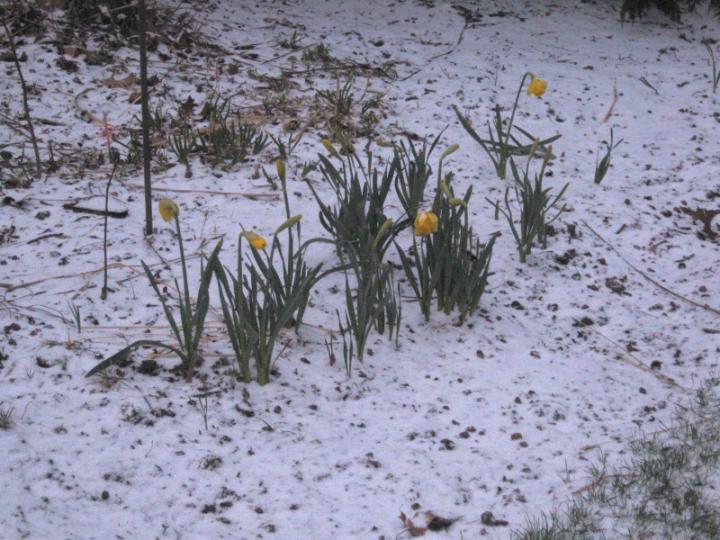
If anyone has seen Spring, please e-mail it some MapQuest directions to Michigan ASAP!
It sounds like a B-grade horror movie. Millions of earthworms, moving silently beneath soil, wreaking havoc until the entire planet is uninhabitable. Sound a little far-fetched? Not to ecologists that study northern hardwood forests. While most of us grew up thinking earthworms were ubiquitous, turns out they are not native in parts of North America that were covered with ice during the last glacial period. Most of us also grew up thinking that earthworms where the good guys/girls (they’re hermaphroditic), churning up compacted soil and leaving nutrient-rich castings behind. In many northern hardwood forests, however, exotic earthworms, have become invasive and ecologists believe they are having profound effect on ecosystems.

I have to admit I hadn’t paid that much attention to the invasive earthworm issue but I attended a seminar last week by Dr. Lee Frelich, Director of the Center for Forest Ecology at the University of Minnesota. Dr. Frelich’s seminar touched on several areas of research, almost all of it extremely depressing, related to climate change and invasive species. He and his colleagues have documented significant changes in soil ecosystem processes and plant succession associated with increasing populations of earthworms. Nightcrawlers, in particular, cause a lot of problems because they consume fresh leaf litter causing it to decompose at a much faster rate compared to un-invaded ecosystems. The net result of these soil changes is that few trees or shrubs can reproduce in the understory. Over time this may lead to a very different looking forest than exists there today.

Of course, we may end up with a very different forest in any event, given some of the climate change scenarios Dr. Frelich presented. One worst-case model predicted the climate of the Boundary Waters area of Minnesota would resemble that of present-day Oklahoma City by the end of the century. But I try not to worry; I figure by that point I’ll be food for the earthworms anyway.
For more info on the earthworms that ate Minnesota, check out these links, if you dare…
http://www.scientificamerican.com/article.cfm?id=invasive-earthworms-denude-forests
http://www.dnr.state.mn.us/invasives/terrestrialanimals/earthworms/index.html
Often we use our blog space as a soapbox from which to pontificate, but today I’m looking for some input from our loyal readers. Last week I received a note from an editor looking for some words about tree rings. We’re talking about landscape tree rings for planting annuals or perennials, not dendrochronology.
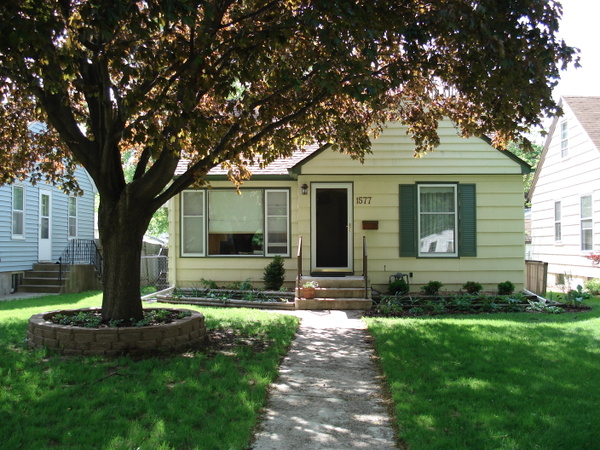
The editor was interested in specifics on tree rings for large existing trees such as what type of materials to use, what types of flowers or plants worked best, which trees can or can’t have tree rings, etc. My reply was short, maybe even a little curt, “I don’t have any experience with tree rings but our general recommendation is to avoid grade changes around trees whenever possible. After I sent the reply I started thinking, is there any real harm to tree rings? I’ve seen some that looked pretty nice (seen many that look like crap, too). For most trees the amount of surface area covered is small compared to total surface root area. If care is taken not to bury the root collar and trunk, would the tree notice covering a little bit of mostly structural roots? Would appreciate thoughts (pro and con) from those with direct experience.
Recently I posted that many of the “rules” that gardeners cling to so tightly regarding tree planting (i.e., dig the planting hole 3 times the width of the root ball, always amend the backfill with organic matter) are probably better considered ‘suggestions’ than rules. While these practices won’t hurt, there are much better ways to spend time and effort to ensure long-term survival when planting a tree. Here are the top four:
Irrigate. No matter how much time and effort goes into the ‘perfect’ planting hole; for most parts of the country, trees that are not irrigated after planting are doomed. Linda advocates watering in several small sips during the week; I still stick to the old school notion of one long soak per week. In the final analysis, logistics will probably dictate which approach you use. Either way, the key is to provide trees with water during the establishment year and even into the second year after planting, if possible.
Mulch. Organic matter placed properly on top of the planting hole will do more good than organic matter placed in the planting hole. Study after study demonstrates that mulch conserves soil moisture by reducing evaporation from the soil surface, controls weeds, and moderates soil temperature. Oh, and that business about wood-based mulches ‘tying up’ or ‘stealing’ nutrients from landscape plants? Maybe for bedding plants, but not for trees and shrubs. Our research and other studies indicate that, for the most part, the type of organic mulch makes little difference compared to not mulching at all. Hence, my motto “Mulch: Just do it.”

Proper planting depth. Width of the planting hole may not matter, but planting trees too deep is a recipe for disaster. Burying roots too deep reduces oxygen levels around the roots and starts a series of unfortunate events for the tree. Find the root collar flare and keep it visible.
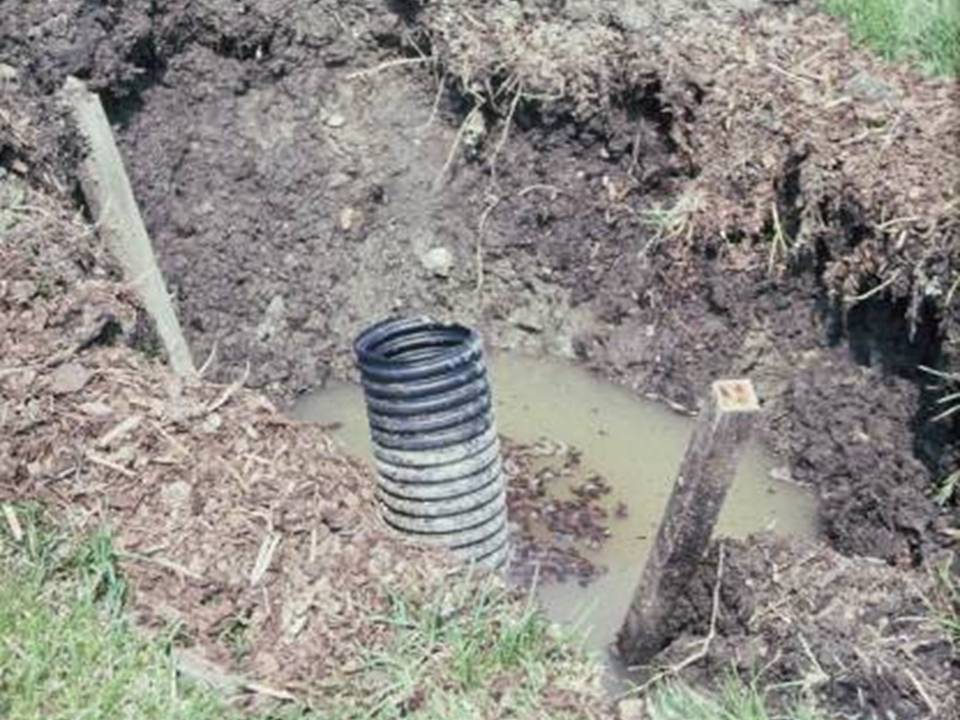
Bad move. The contractor was going to install drain tile but decided not to at the last minute to save money. Ouch.
Right tree, right place. In my experience, the number one reason newly-planted trees fail in the first year is lack of watering and aftercare. After year one, improper tree selection takes the top spot. Here in the Upper Midwest, poor drainage and heavy soils take their toll year after year. Lack of water can usually be addressed, but once a tree is planted in a spot that is too wet for that species, it’s usually a long, slow, and agonizing decline. And it’s amazing how often people will ignore obvious red flags in selecting trees. Our Dept. of Transportation recently planted 25 eight-foot B&B eastern white pine, which are notoriously salt sensitive, about 30’ from I-96 at a rest area between Lansing and Detroit. Predictably, after one winter’s exposure to deicing salt spray all the trees were dead or wishing they were dead. Right tree, right place. This ain’t rocket science, folks.
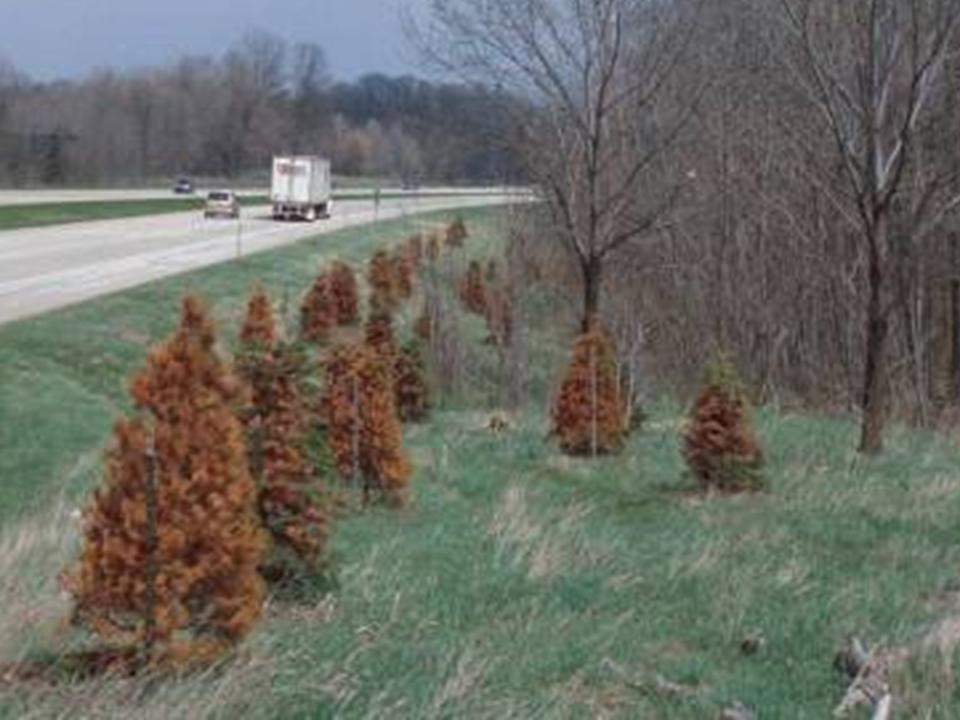
Well, it looks like the climate change skeptics are starting to hedge their bets. Global climate is not changing. But if it does change, it’ll change for the better. At least that’s the gist of a book by the Center for the Study of Carbon Dioxide and Global Change entitled “The Many Benefits of Atmospheric CO2 Enrichment”. The book documents 55 different ways that increasing global CO2 will benefit the world. Most of this is built on studies documenting increases in plant growth and/or photosynthesis associated with increasing CO2. If you’re interested you can look at a preview of the book at:
http://www.co2science.org/education/book/2011/55BenefitsofCO2Pamphlet.pdf

While CO2 enrichment can benefit plants and trees in the short term, it’s less clear how they will respond over the long term. For example, nutrition or water may soon become limiting such that the full CO2 ‘fertilization’ effect is never realized. Also, it’s likely that certain plants will benefit more from increased CO2 than others: Will exotic invasives gain an additional advantage over natives? And, of course, if rising CO2 results in increased global temps (which the Center denies) then all bets are off.
You can learn more about the Center for the Study of Carbon Dioxide and Global Change at their website http://www.co2science.org/ There is a tab on the homepage where you can donate to support their cause. Why not? Exxon/Mobil already has.
This past weekend GP Jeff Gillman and I were in Midland, Michigan for two different conferences and had a chance to catch up over dinner (Boulevard burgers – best in Midland) and a couple of cold Bell’s stout ales. It was nice to visit with Jeff since we have so much in common but rarely get to see each other. As you might suspect, our conversation centered on negotiating the perils of the tenure and promotion process at research intensive universities, dealing with bumbling administrators, and, of course, our fellow Garden Professors. Quick Garden Professor trivia: Who’s the shortest Garden Professor? (Answer below).
Another item we discussed is how frantically worked up some people about following the various landscaping ‘rules’, especially for tree planting.
I have a program that I do on soil amendments. I present 6 or 7 examples from about 30 studies that I’ve collected from the literature that show that amending backfill when planting trees provides little, if any, value. Invariably, 2 or 3 audience members race up to podium after the Q & A, veins popping out of their foreheads.
“You have to add compost/peat/hydrogel/cow manure/take your pick when you plant!” they sputter.
I counter, “No you don’t. I just showed you a half dozen examples where it didn’t matter; if I had time I could’ve shown you two dozen more.”
The conversation usually turns one of two directions from there.
“Well, I saw a gardening expert on TV and they said you always have to add compost/peat/hydrogel/cow manure/take your pick when you plant.”
The other variation is: “Well, I always add compost/peat/hydrogel/cow manure/take your pick when I plant trees and shrubs and they do great.”
“Did you try any without the compost/peat/hydrogel/cow manure/take your pick? ”
“No, why would I? They always do great when I add compost/peat/hydrogel/cow manure/take your pick !”
As part of the soil amendment talk I present some data from a tree planting study which also included a comparison of width of the planting hole (1.2 times the width of root-ball, 2x root-ball width, and 3x root-ball width). After three years, width of planting hole had no effect on shoot or diameter growth. At this point in the talk I wait ten seconds before I move on to allow the results to sink in. By the time the next slide hits the screen half the audience is in a state psychologists refer to as ‘cognitive dissonance’.
People just can’t get over it. Another race to the podium after the talk, “But you have to dig the hole 3 times the width of the ball.”
“Can if you want to, but I wouldn’t say have to.”
“But, but…”
Clearly, there are things that shouldn’t be done when planting trees, like planting too deep. But a lot of things we “know” are based on what sounds right, on what feels right; not necessarily on science. Many practices have worked their way into extension bulletins, fact sheets, and our communal knowledge through sheer repetition. Often times, these are things that won’t hurt the tree (adding amendments or making a wider planting hole) but make the job harder than it has to be.
Point is, we need to take a deep breath, get a grip, and be careful with absolutes like ‘never’ and ‘always’. Working with trees is a lot like working for a university; it requires a high tolerance for ambiguity. Trees are living dynamic organisms that are able to respond and acclimate to their environment. I’ve stated many times that trees often grow more in spite of us than because of us. So calm down and carry on.
GP Trivia answer: At a hair over 5’8”, I am the shortest GP.
We typically think of trees as the ‘good guys’; they shade our homes and yards, they take up carbon dioxide and pollutants from the air, they give us oxygen. What’s not to like? Well, like a lot of good guys, trees can also have a dark side. One of the more sinister habits some trees have is getting into sewer lines. Some studies estimate that trees are responsible for up to half of sewer line repair costs. The prospect of trees getting into residential sewer lines is troublesome, of course, because it’s an invisible problem; we usually don’t know there’s an issue until there’s an issue. Once tree roots get into sewers, they are often expensive and messy to deal with. And I don’t mean just messy in the sense of having to call in a backhoe to dig up your yard. Deciding who is responsible for the cost of cleaning up after a tree figures out its hit the mother lode can be a mess as well. What if your neighbor’s sycamore finds its way into your pipes? Or what if the culprit is the silver maple that you didn’t want but the city planted in the tree lawn anyway? In some cases there are city ordinances that cover these situations. For example, some cities will cover damage from city-owned trees provided they determine the city-owned tree caused the damage and the damage wasn’t due to a pre-exiting problem with the pipes. Therein lies the rub. As long as sewer pipes are intact and functional, tree roots have a hard time penetrating. The problems usually arise when pipes crack or joints fail. Once roots find an opening, it’s Katie bar the door. This is why tree-sewer problems are most common in older systems with clay or concrete pipes that can crack over time. Of course, the type of tree and location play a role as well. Other factors being equal, fast-growing bottomland species are the most frequent offenders. Danish researchers found that willow, birch, and poplar trees were responsible the largest number of root intrusions into sewer lines. In many parts of the US, sycamore, sweetgum, and tulip-poplar can be added to the list.

Tree roots and sewer lines: a bad combination
So what’s a homeowner to do to get some sleep and not worry about tree roots planning a silent assault on the drain-lines? Keeping fast-growing trees away from lines is a start. But tree roots can grow a long ways and are pretty relentless; if there is a crack or a weak spot in the pipes, they will find it. Keeping the system maintained and preventing entry is the key. If the system has cracks, “Root-stopper” or “root-killer” products are available. These are copper-based materials similar to ‘spin-out’ used on tree containers to prevent circling roots. These will kill feeder roots that have entered into pipes, but roots are persistent and they’ll be back. Plumbers have special tools that they can snake through the system that can cut through roots and clear blocked lines – at least for awhile. If you have old sewer lines and have fast-growing trees around, you may want to consider hiring a plumber do a video inspection of your lines periodically (think of it as a colonscopy for your house). If there’s a problem the plumber will be able to pin-point where it’s at and (hopefully) fix it before it becomes a major expense.
A short follow up to last weeks post on girdling roots. Just to reiterate, the point of the post was that we need to be careful not to jump to conclusions when assessing tree problems. It’s important to look beyond the first defect we see and consider additional causes. And to also reiterate, girdling roots can be a serious problem and can lead to tree failures. The photo below shows an example of tree that was both planted too deep and had stem girdling roots. The result was a weakened area in the trunk, which was subject to breakage during a windstorm.

Many people also assume that girdling roots restrict flow of water and nutrients in the xylem. They can, but trees also have the ability graft roots and re-establish connections between roots. In the study I mentioned last week, Phillip Kurzeja and his co-workers traced water flow in ’manifold roots’ (a series of interconnected, girdled roots) by injecting dye. The trees were subsequently felled and de-barked, allowing the researchers to determine whether the roots were still functional. As shown below the girdled roots were able to re-establish their vasculature and continue to translocate water up the stem. So trees can be efficient at fixing their own pipes!
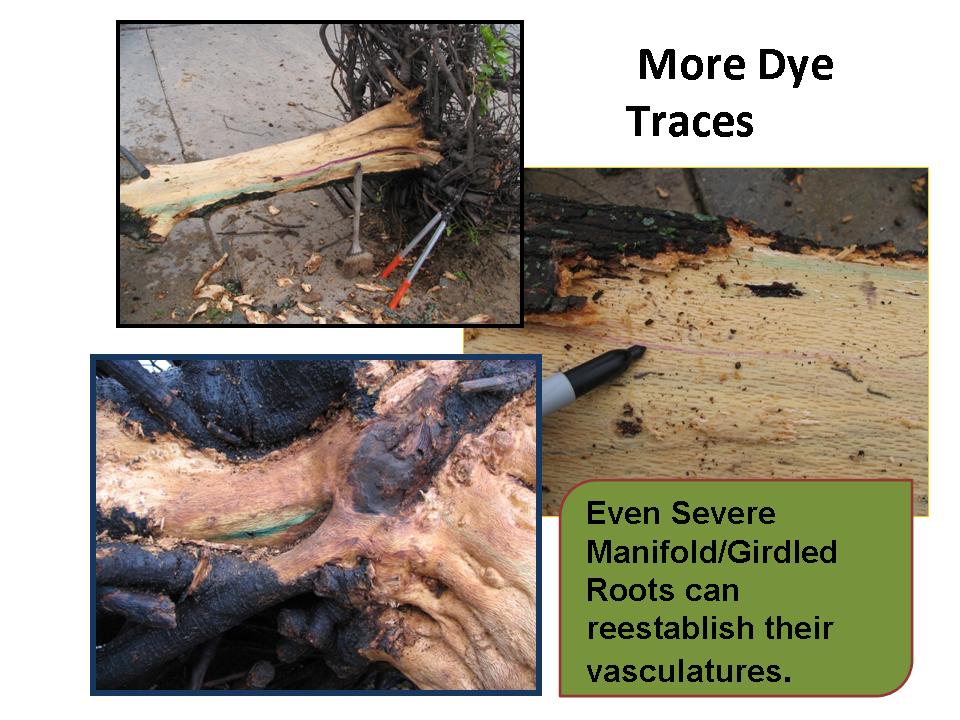
Image: Phillip Kurzeja
It is important to note that this phenomenon occurs between roots but not between roots and the main trunk – hence the concern for impact of stem-girdling roots, especially for trees planted too deep.
One of the most widely discussed topics in arboriculture and tree care these days is the problem of girdling roots. Virtually every conference or workshop on tree care has a speaker or speakers on how poor planting technique or poor nursery practices lead to girdling roots and their subsequent correlation with poor tree performance, tree failures, global warming, the soaring Federal budget deficit, and the batting average of the Seattle Mariners. Before we go any further let me state categorically that I do not think girdling roots are a good thing; nor do I think any of the consequences mentioned are a laughing matter – especially the Mariners’ batting average. I do think, however, that we often see a rush to judgment as soon as girdling roots are found on trees that are declining or have died. I attribute at least part of this to the increased availability of air spades for excavating tree roots. I have nothing against air spades; they are useful tools and a great way to non-destructively examine and treat roots and even move trees. The problem is that often when people see a tree in decline they examine the roots, see a girdling root, conclude that was the problem and blame the person that planted the tree (unless they were the person that planted the tree, then they blame the nursery).

Example of oak tree with leaf scorch (Photo Phillip Kurzeja)
A recent study here at Michigan State presented by Phillip Kurzeja at the recent Arboriculture Society of Michigan ArborCon, points out the importance of looking beyond girdling roots in assessing tree problems.
The problem: Oak trees at several locations on the MSU campus have been suffering severe leaf scorch. In some cases virtually 100% of the leaves on the trees are affected and growth has been severely affected. Examination of the trees by a pathologist ruled out bacterial leaf scorch, suggesting that the problem may be abiotic. The researchers looked at a battery of variables including degree of leaf scorch, number of girdling roots, planting depth, soil compaction, foliar nutrition, leaf water potential, and leaf photosynthetic function. Most importantly, they looked at these traits on trees without scorch as well as trees with scorch.

Evaluating girdling roots (Photo Phillip Kurzeja)
The results: Trees with mild or severe scorch leaf scorch had girdling roots. At this point one might have leapt to the conclusion that the girdling roots were responsible for the leaf scorch. But girdling roots were also found in trees that did not have any leaf scorch. In fact, in some cases the healthy trees had more severe girdling roots than trees with the worst leaf scorch. So, what factors differed between trees with scorched and un-scorched leaves? The researchers are still working on the analyses but the most obvious differences were that trees with leaf scorch were consistently planted deeper and had lower levels of foliar manganese than healthy trees.
The presentation I saw did not include data on soil pH or soil nutrient levels, so it’s impossible at this point to establish causal relationships among planting depth, foliar manganese, and leaf scorch. But, for those who have to answer the ‘what’s wrong my tree?’questions, this study does point out the importance of keeping an open mind and looking at a variety of factors and not leaping on the first defect to appear.
As those that have followed the blog for awhile are aware, among my pet peeves are some of the naïve statements that are repeated ad nauseam by proponents of native plants for landscaping. You know the usual litany: natives don’t need water, don’t need fertilizer, resistant to insects, resistant to diseases, yada, yada… According to the dogma, native plants possess these traits because they’ve evolved here and they belong here. I hasten to point out; I have nothing against natives and think we ought to plant more of them whenever they are an appropriate choice. The problem, of course, with the typical native company line is that these statements are so obviously nonsensical they undermine the credibility of native plant advocates. Adaptations to resist environmental stress, for example, are a function natural selection and evolution. There are lots of droughty environments in the world; why should we assume that only local plants will be adapted to drought? Then there is the obvious problem of disturbed environments. Why should we assume that trees that have evolved in native woodlands will be good street trees? In fact, often they’re not.
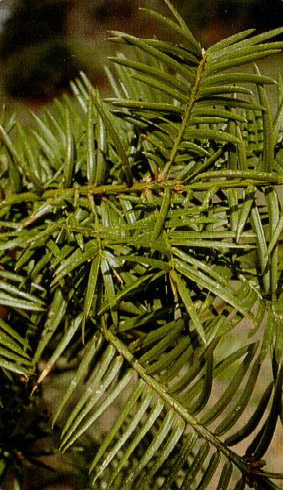
Torryea taxifolia
But a new and potentially contentious argument is emerging in the ‘Is native better?’ discussion: Assisted migration. The basic premise of assisted migration (also referred to as assisted colonization) is that climate is changing faster than many organisms, especially long-lived organisms like trees, can evolve. Therefore to prevent species extinctions we should pro-actively move species (typically northward in the Northern hemisphere) so they will be in a better place as the world gets warmer. Sound far-fetched? Some of this is already occurring. In Florida a group called the Torreya Guardians has already taken it upon themselves to establish populations of a threatened conifer, Torreya taxifolia, in the southern Appalachians, outside of its native range in the panhandle of Florida. http://www.torreyaguardians.org/ In British Columbia, the provincial forest service is beginning to incorporate climate change scenarios into its tree improvement and development plans; trying to identify seed sources and species adapted to climates predicted throughout the 21st century.http://www.msnbc.msn.com/id/32012170/ns/us_news-environment/
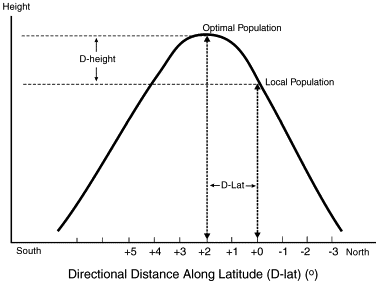
Is local better? Foresters often see significant growth gains by moving seed sources northward. Will climate change increase this effect?
Clearly assisted migration is a controversial topic fraught with all kinds of uncertainties. Is climate really changing? How fast will it change? What about unintended consequences? Could the assisted species out-compete a local species that would’ve been OK otherwise? And then there are those who might wonder aloud about the hypocrisy of embracing species movements when they’re done by conservation biologists but not by horticulturists.